
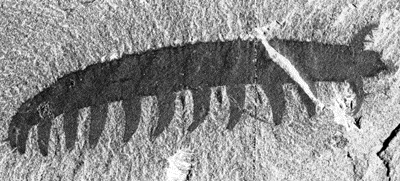
Cambrian Beasts
Worms
In the Vendian Period (620-540 million years ago), worm burrows become
increasingly numerous. Indeed, recently, larvae of segmented worms have been found in the
Doushantuo formation of China. Since just prior to the Vendian the only evidence for
macroscopic life was that of the worms, if the various phyla were to evolve, it must have
been from the worms.
Arthropods
Many of the Cambrian creatures appear to be arthropods, the large classification of animals that includes insects, spiders, crabs, lobsters, and so forth. We can speculate on how these creatures evolved from the much simpler forms in the Vendian/Ediacaran era.
An animal similar to the lobopod, Aysheaia might represent a step in this transformation:
 |
 |
It appears to be a 'worm' with ‘legs’, which are lobopods. A lobopod consists of muscles surrounding a blood-filled cavity. Lobopods are soft and pliable but they accomplish the purpose of moving the animal along. Each lobopod has a couple of claws at its end and the front two have spikes which apparently serve the purpose of grasping prey.
Anomalocaris may also lie in the line leading to arthropods:
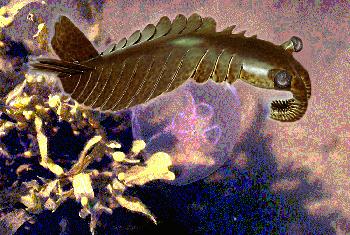 |
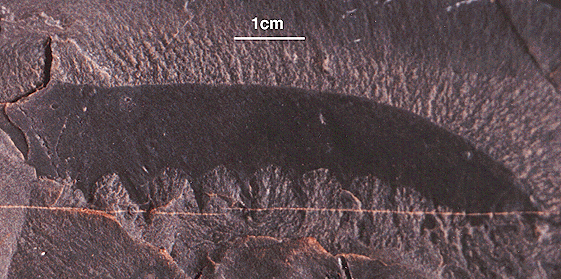 |
Anomalocaris shows its relation to the lobopodians by having lobopods for legs. In addition it has a tail fan and flaplike projections that perform several purposes: protection, propulsion, and respiration:
“Of these, perhaps the last was the most important. Imagine that in due course the flaps seen in Anomalocaris were modified. The leading edge now formed an elongate bar and behind it the structure was transformed in a series of trailing filaments. This, of course, would be reminiscent of the gills that arise above the walking legs of many arthropods. Thus, if the lobopod limbs were transformed into jointed appendages and the flaps into gills, then one could envisage, at least in broad outline, the transformation between an animal similar to Anomalocaris and a fully fledged arthropod.” - Conway Morris (1998, p. 184)
Thus Anomalocaris has traits that link it to the lobopods as well as to the arthropods.
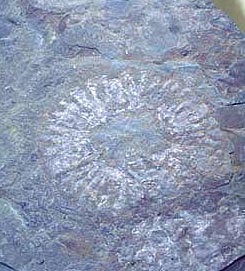 |
But it also has traits that link it
to even more ancient ancestors. Its mouth is wormlike, with teeth radiating around the
mouth itself. Being related to worms is not inconsistent with being related to arthropods IF the animal is in the process of evolving from worms into arthropods. The mouth of Anomalocaris is seen at: |
A vast variety of arthropods and closely related animals evolved:
Wiwaxia |
Opabinia |
|
 |
Halucenia |
Trilobite |
 |
|
So broad is the variety of such animals that some have thought that they may have represented new families of animals that have since died out and have no modern surviving representatives (Gould). However, a careful analysis of basic features shows them to be part of the arthropod branch of animal designs (Conway Morris).
So, what we find in the fossil record are animals with all stages of the transition between worms and arthropods: 1. worms; 2. lobopods; 3. Anomalocaris with both lobopods and arthropod appendages and possible incipient arthropod gills; and 4. arthropods.
Brachiopods
Brachiopods are another distinct Cambrian animal form. The evolutionary lineage of the Brachiopods appears to begin with a creature called Halkieria evangelista from the Sirius Passet formation of Greenland which is about 525 million years ago.
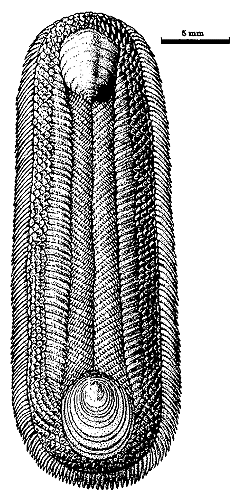 |
This animal has three broad zones of hollow scales. These scales are hollow and are inserted into the animal's body in such a fashion as to make a chainmail-like armor covering the body of the metazoan. These small scales overlap and make a flexible armor with which to defend against attack. The back of the animal has palm-shaped scales, the sides have knife-shaped of scales and the edges of the belly have sickle-shaped scales. This will become important later when we talk about an animal transitional to the annelids. The bottom of Halkieria was soft, without scales and could best be described as being like a snail's bottom. It enabled the animal to glide across the ocean floor. This fact will become important when we talk about annelids and mollusks. Halkieria can be seen at http: http://www.palaeos.com/Invertebrates/Procoelomates/Halkieriida.html |
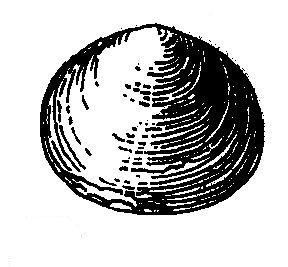 |
The shell at the ends of Halkieria is very similar to the shells of the brachiopods seen in the earliest Cambrian strata. What is believed to have taken place is that the two shells at each end of Halkieria were used by this animal as protection devices. The animal would curl up between the plates when threatened. There are other facts that support this interpretation. The edges of brachiopod shells have chitinous bristles, called setae, which extend away from the shell. The microscopic structure of the setae is identical to that of the chaetae of polychaete worms and we will see that these evolved from the scales of Halkieriids. In some of the brachiopods the setae are segmented as is the case with Halkierian scales. And finally, "Neocrania", a modern brachiopod begins life as mobile animal that moves across the ocean floor, bearing the setae of a brachiopod but lacking the shell. Eventually it settles down, folds itself in the middle, secretes a shell and remains fixed like others of their kind. This is the type of action Conway Morris postulates as the steps leading from Halkieria to brachiopods. |
1. Climate Change - It appears that the period prior to the Cambrian era was marked by very cold temperatures. In fact, a somewhat controversial theory, termed "Snowball Earth," claims that there was so much ice that much of the sun light was reflected and we came close to entering an irreversible downward spiral in temperature as less and less of the sun's energy was absorbed by the surface of the planet. Thus, the Vendian/Ediacaran life forms would have been contending with very unfavorable conditions. Under this theory, the seeds of the Cambrian Explosion were planted during this earlier period, and when there were vast new possibilities for life in new and more favorable conditions, an explosion of new life forms occurred to fill these new niches.
2. Development of Predators - PreCambrian fossils show little evidence for predators. Clearly, predators were prevalent and highly dangerous to Cambrian life. Evolution responds to challenge. Predators require many adaptations to find their prey - ability to move rapidly toward a target without losing track of it, hunting strategies, grasping the prey - all of which would also lead to development of brains and advances in nervous systems. The necessity to fend off predators to survive would have also triggered a great acceleration in the rate of evolutionary change in other animals, including the development of protective outer armor (shells, or the scale-like structures and spines of the Wiwaxia).
3. Evolutionary Breakthrough - Perhaps some new feature developed by chance during evolution of the precambrian life forms that provided a huge advantage. An example would be the development of an exoskeleton that would provide rigidity against which muscles could work, making it suddenly advantageous for complex animals to develop.
4. Changes in Ocean Chemistry or in Geography - The Cambrian occurred at the time plate tectonics were breaking up a super-continent, and also at a time when a large amount of phosphorus was being deposited on the shallow undersea shelves surrounding the continents. Phosphorus is an essential ingredient for life. Another twist is that the phosphorus was to abundant that animals had to fight being poisoned by depositing it into shells. Or perhaps some other chemical or geographical change helped trigger the explosion.
5. Rapid Climate Fluctuations - Marine sediments show 10 large oscillations during the Cambrian period in the amount of carbon 13, which we think indicates a series of global extinctions and recoveries. Perhaps the challenges of adapting to such a rapidly changing environment produced a period of evolutionary breakthroughs.
Material from http://home.entouch.net/dmd/cambevol.htm, G. Morton; "Wonderful Life," S. Gould; "The Crucible of Creation: The Burgess Shale and the Rise of Animals," by S. Conway Morris; and "Evolving Brains," by John Allman..